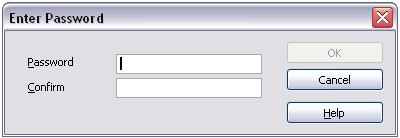Difference between revisions of "Documentation/OOoAuthors User Manual/Getting Started/File Management"
(→Creating new files) |
(→File formats) |
||
| Line 31: | Line 31: | ||
{| | {| | ||
| − | ||'''OpenDocument type'''||'''Application'''||'''Extension'''||'''MS Office equiv'''|| | + | ||'''OpenDocument type''' ||'''Application''' ||'''Extension''' ||'''MS Office equiv'''|| |
|- | |- | ||
||Text||Writer||.odt||.doc|| | ||Text||Writer||.odt||.doc|| | ||
Revision as of 05:11, 14 June 2007
Template:NeedsWork This page was created by converting ODT to Mediawiki using Writer2MediaWiki.
This is Chapter 3 of Getting Started with OpenOffice.org 2.x (Third edition), produced by the OOoAuthors group. A PDF of this chapter is available from the OOoAuthors Guides page at OpenOffice.org.
<< User Manuals page
<< Getting Started Table of Contents
<< Chapter 2 Starting OpenOffice.org |
Chapter 4 Menus and Toolbars >>
Contents
Opening files
To open an existing document, choose File > Open or click the Open File icon on the Standard Toolbar or press Control+O.
The Open dialog appears. Figure 1 shows the Windows XP version of this dialog.
- inline:Frame2.png
Choose the file and then click Open.
Note: Under Microsoft Windows you can use either the OpenOffice.org Open and Save As dialogs or the ones provided by Microsoft Windows. See Using the Open and Save As dialogs.
File formats
OpenOffice.org can import Microsoft Office files. However, at the time of writing, Microsoft Office cannot import files in the OpenDocument format used by OOo. Plug-ins are becoming available to allow Microsoft Office to read and write OpenDocument files, but if you want to send a file to Microsoft Office users and be sure they can open it, save it in a Microsoft Office format or in .rtf. Table 1 is a list for quick reference.
Table 1: Comparison of OpenDocument and Microsoft Office file types
| OpenDocument type | Application | Extension | MS Office equiv | |
| Text | Writer | .odt | .doc | |
| Text Template | Writer | .ott | .dot | |
| Master Document | Writer | .odm | .doc | |
| Spreadsheet | Calc | .ods | .xsl | |
| Spreadsheet Template | Calc | .ots | .xst | |
| Drawing | Draw | .odg | N/A | |
| Drawing Template | Draw | .otg | N/A | |
| Presentation | Impress | .odp | .ppt | |
| Presentation Template | Impress | .otp | .pot | |
| Formula | Math | .odf | N/A | |
| Chart | Chart | .odc | N/A | |
| Database | Base | .odb | .mdb |
Default file formats
OpenOffice.org saves files in the OpenDocument format by default unless told otherwise. This default can be changed, for example, if you always want to save as Microsoft Office files. To change the default file formats:
- Go to Tools > Options > Load/Save > General. (See Figure 2.)
- In the Default file format section of this page, choose a document type (for example, “Text document") and a file format from the Always save as list.
- Repeat for each document type, as necessary.
- Click OK to save your changes.
Notes: If the option "Warn when not saving in OpenDocument or default format" is checked on the Options - Load/Save - General dialog (Figure 2), a warning dialog about potential loss of formatting may be displayed. In most cases, no loss of formatting will occur, so you may find this warning annoying and choose to disable it.
The Java Runtime Environment is required to use the mobile device filters for AportisDoc (Palm), Pocket Word, and Pocket Excel.
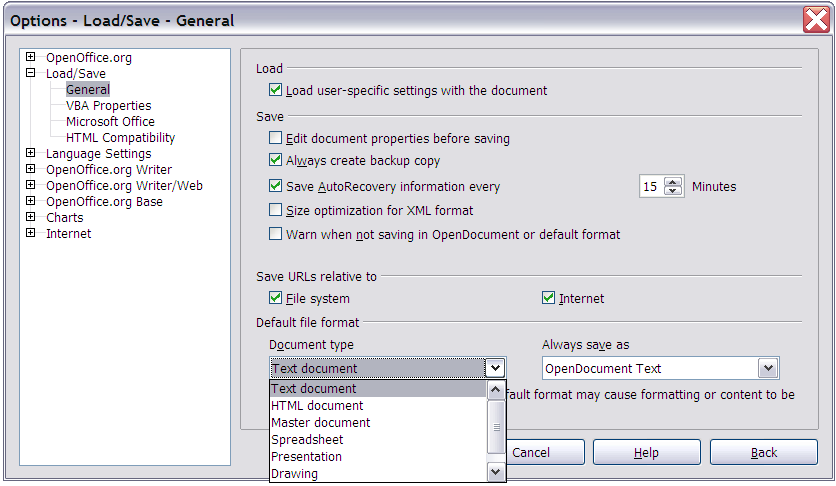
Figure 2. Choosing default formats for saving files
Opening text documents
In addition to OpenDocument formats (.odt, .ott, .oth, and .odm), Writer 2.x can open the formats used by OOo 1.x (.sxw, .stw, and .sxg) and the following text document formats:
| Microsoft Word 6.0/95/97/2000/XP) (.doc and .dot) | WordPerfect Document (.wpd) | |
| Microsoft Word 2003 XML (.xml) | WPS 2000/Office 1.0 (.wps) | |
| Microsoft WinWord 5 (.doc) | DocBook (.xml) | |
| StarWriter formats (.sdw, .sgl, and .vor) | Ichitaro 8/9/10/11 (.jtd and .jtt) | |
| AportisDoc (Palm) (.pdb) | Hangul WP 97 (.hwp) | |
| Pocket Word (.psw) | .rtf, .txt, and .csv |
When opening .htm or .html files (used for web pages), OpenOffice.org customizes Writer for working with these files.
Opening spreadsheets
In addition to OpenDocument formats (.ods and .ots), Calc 2.x can open the formats used by OOo 1.x (.sxc and .stc) and the following spreadsheet formats:
| Microsoft Excel 97/2000/XP (.xls, .xlw, and .xlt) | Rich Text Format (.rtf) | |
| Microsoft Excel 4.x-5.0/95 (.xls, .xlw, and .xlt) | Text CSV (.csv and .txt) | |
| Microsoft Excel 2003 XML (.xml) | Lotus 1-2-3 (.wk1, .wks, and .123) | |
| Data Interchange Format (.dif) | StarCalc formats (.sdc and .vor) | |
| dBase (.dbf) | SYLK (.slk) | |
| .htm and .html files including Web page queries | Pocket Excel (pxl) | |
| Quattro Pro 6.0 (.wb2) |
Opening presentations
In addition to OpenDocument formats (.odp, .odg, and .otp), Impress 2.x can open the formats used by OOo 1.x (.sxi and .sti) and the following presentation formats:
- Microsoft PowerPoint 97/2000/XP (.ppt, .pps, and .pot)
- StarDraw and StarImpress (.sda, .sdd, .sdp, and .vor)
- CGM - Computer Graphics Metafile (.cgm)
Opening graphic files
In addition to OpenDocument formats (.odg and .otg), Draw 2.x can open the formats used by OOo 1.x (.sxd and .std) and the following graphic formats:
| BMP | JPEG, JPG | PCX | PSD | SGV | WMF | |
| DXF | MET | PGM | RAS | SVM | XBM | |
| EMF | PBM | PLT | SDA | TGA | XPM | |
| EPS | PCD | PNG | SDD | TIF, TIFF | ||
| GIF | PCT | PPM | SGF | VOR |
Opening formula files
In addition to OpenDocument Formula (.odf) files, Math 2.x can open the format used by OOo 1.x (.sxm), StarMath, (.smf), and MathML (.mml) files.
When opening a Word document that contains an embedded equation editor object, if the option for it is checked in Tools > Options > Load/Save > Microsoft Office, the object will be automatically converted to an OpenOffice.org Math object.
Saving files
To save a new file:
- Choose File > Save As.
- When the Save As dialog appears, enter the file name and verify the file type (if applicable).
To save an open document with the current file name, choose File > Save. This will overwrite the last saved state of the file.
Password protection
To protect an entire document from being viewable without a password, use the option on the Save As dialog to enter a password. This option is only available for files saved in OpenDocument formats or the older OpenOffice.org 1.x formats.
- On the Save As dialog, select the checkbox beside Save with password, and then click Save. You will receive a prompt:
- Type the same password in the Password field and the Confirm field, and then click OK. If the passwords match, the document is saved password protected. If the passwords do not match, you receive the prompt to enter the password again.
Note: Passwords must contain a minimum of 5 characters. Until you have entered 5 characters, the OK button remains inactive.
Saving a document automatically
You can choose to have OpenOffice.org save files for you automatically. Automatic saving, like manual saving, overwrites the last saved state of the file. To set up automatic file saving:
- Choose Tools > Options > Load/Save > General. (See Figure 2.)
- Mark Save AutoRecovery information every, and set the time interval.
Writer can save to these file formats
In addition to OpenDocument formats (.odt and .ott), Writer 2.x can save in these formats:
- OpenOffice.org 1.x Text Document(.sxw)
- OpenOffice.org 1.x Text Document Template (.stw)
- Microsoft Word 6.0, 95, and 97/2000/XP (.doc)
- Microsoft Word 2003 XML (.xml)
- Rich Text Format (.rtf)
- StarWriter 3.0, 4.0, and 5.0 (.sdw)
- StarWriter 3.0, 4.0, and 5.0 Template (.vor)
- Text (.txt)
- Text Encoded (.txt)
- HTML Document (OpenOffice.org Writer) (.html and .htm)
- DocBook (.xml)
- AportisDoc (Palm) (.pdb)
- Pocket Word (.psw)
Note: The .rtf format is a common format for transferring text files between applications, but you are likely to experience loss of formatting and images. For this reason, other formats should be used.
Calc can save to these file formats
In addition to OpenDocument formats (.ods and .ots), Calc 2.x can save in these formats:
- OpenOffice.org 1.x Spreadsheet (.sxc)
- OpenOffice.org 1.x Spreadsheet Template (.stc)
- Microsoft Excel 97/2000/XP (.xls and .xlw)
- Microsoft Excel 97/2000/XP Template (.xlt)
- Microsoft Excel 5.0 and 95 (.xls and .xlw)
- Microsoft Excel 2003 XML (.xml)
- Data Interchange Format (.dif)
- dBase (.dbf)
- SYLK (.slk)
- Text CSV (.csv and .txt)
- StarCalc 3.0, 4.0, and 5.0 formats (.sdc and .vor)
- HTML Document (OpenOffice.org Calc) (.html and .htm)
- Pocket Excel (.pxl)
Note: The Java Runtime Environment is required to use the mobile device filters for AportisDoc (Palm), Pocket Word, and Pocket Excel.
Impress can save to these file formats
In addition to OpenDocument formats (.odp, .otp, and .odg), Impress 2.x can save in these formats:
- OpenOffice.org 1.x Presentation (.sxi)
- OpenOffice.org 1.x Presentation Template (.sti)
- Microsoft PowerPoint 97/2000/XP (.ppt and .pps)
- Microsoft PowerPoint 97/2000/XP Template (.pot)
- StarDraw, StarImpress (.sda, .sdd, and .vor)
Impress can also export to MacroMedia Flash (.swf) and any of the graphics formats listed for Draw.
Draw can save to these file formats
Draw can only save in the OpenDocument Drawing formats (.odg and .otg), the OpenOffice.org 1.x formats (.sxd and .std) and StarDraw format (.sda, .sdd, and .vor).
However, Draw can also export to BMP, EMF, EPS, GIF, JPEG, MET, PBM, PCT, PGM, PNG, PPM, RAS, SVG, SVM, TIFF, WMF, and XPM.
Writer/Web can save in these formats
- HTML document (.html and .htm)
- OpenOffice.org 1.0 HTML Template (.stw)
- OpenOffice.org 2.x HTML Template (.oth)
- StarWriter/Web 4.0 and 5.0 (.vor)
- Text (OpenOffice.org Writer/Web) (.txt)
- Text Encoded (OpenOffice.org Writer/Web) (.txt)
Exporting files
Export to XHTML, BibTeX, LaTeX, and Flash
OpenOffice.org can export files to XHTML.
In addition, OOo Writer can export to BibTeX (.bib) and LaTeX 2e (.tex). OOo Draw and OOo Impress can export to Macromedia Flash (.swf).
To export to one of these formats, choose File > Export. On the Export dialog, then select the required format in the File format list.
Export to PDF
OpenOffice.org can directly export to PDF. This industry-standard file format for file viewing is ideal for sending the file to someone else to view using Acrobat Reader or other PDF viewers.
You can export directly to PDF using a button on the toolbar inline:Graphic9.png or by choosing File > Export as PDF'.'
If you use File > Export as PDF, you are asked to enter the filename for the PDF file, and then the PDF Options dialog (Figure 3) opens.
| Note | If you use the Export Directly as PDF button, you are asked to enter the filename for the PDF file, but you cannot choose a page range, the image compression, or other export options. |
PDF options
The PDF Options dialog has four pages (General, Initial View, User Interface, Security). Make your selections, and then click Export.
General page of PDF Options dialog
On the General page (Figure 3), you can choose which pages to include in the PDF, the type of compression to use for images (which affects the quality of images in the PDF), and other options.
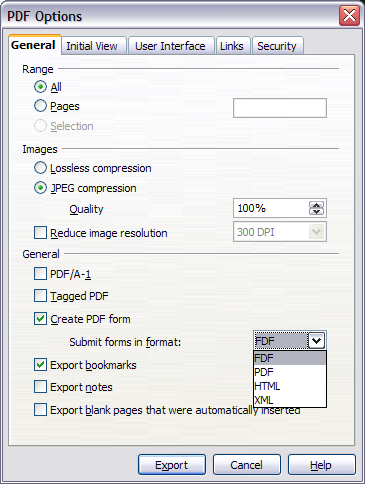
Figure 3. General page of PDF Options dialog
Range section
- All: Exports the entire document.
- Pages: To export a range of pages, use the format 3-6 (pages 3 to 6). To export single pages, use the format 7;9;11 (pages 7, 9, and 11). You can also export a combination of page ranges and single pages, by using a format like 3-6;8;10;12.
- Selection: Exports whatever material is selected.
Images section
- Lossless compression: Images are stored without any loss of quality. Tends to make large files when used with photographs. Recommended for other images.
- JPEG compression: Allows for varying degrees of quality. A setting of 90% tends to work well with photographs (small file size, little perceptible loss).
- Reduce image resolution: Lower-DPI (dots per inch) images have lower quality.
Note: EPS images with embedded previews are exported only as previews. EPS images without embedded previews are exported as empty placeholders.
General section
- Tagged PDF: Includes special tags into the corresponding PDF tags. Some tags that are exported are table of contents, hyperlinks, and controls. This option can increase file sizes significantly.
- Export notes: Exports notes in Writer and Calc documents as PDF notes.You may not want this!
- Export bookmarks: Exports headings as "bookmarks" (a table of contents list displayed by some PDF readers, including Adobe Reader).
- Create PDF form - Submit format: Choose the format of submitting forms from within the PDF file. This setting overrides the control's URL property that you set in the document. There is only one common setting valid for the whole PDF document: PDF (sends the whole document), FDF (sends the control contents), HTML, and XML. Most often you will choose the PDF format.
- Export automatically inserted blank pages: If selected, automatically inserted blank pages are exported to the PDF. This is best if you are printing the PDF double-sided. For example, books usually have chapters set to always start on an odd-numbered (right-hand) page. When the previous chapter ends on an odd page, OOo inserts a blank page between the two odd pages. This option controls whether to export that blank page.
Initial View page of PDF Options dialog
On the Initial View page (Figure 4), you can choose how the PDF opens by default in a PDF viewer. The selections should be self-explanatory.
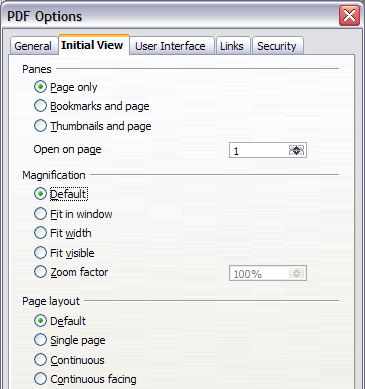
Figure 4. Initial View page of PDF Options dialog
User Interface page of PDF Options dialog
On the User Interface page (Figure 5), you can choose more settings to control how a PDF viewer displays the file. Some of these choices are particularly useful when you are creating a PDF to be used as a presentation or a kiosk-type display.
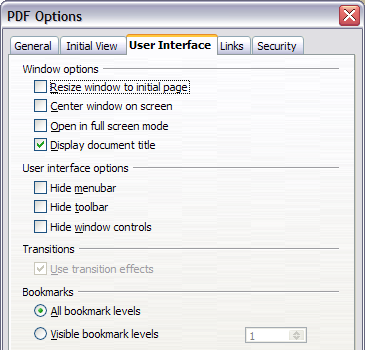
Figure 5. User Interface page of PDF Options dialog
Window options section
- Resize window to initial page. PDF viewer resizes to fit the first page of the PDF.
- Center window on screen. PDF viewer window is centered on the computer screen.
- Open in full screen mode. PDF viewer opens full-screen instead of in a smaller window.
- Display document title. PDF viewer displays the document's title in the title bar.
User interface options section
- Hide menubar. PDF viewer hides the menu bar.
- Hide toolbar. PDF viewer hides the toolbar.
- Hide window controls. PDF viewer hides other window controls.
Transitions section
Includes Impress slide transition effects in the respective PDF effects.
Bookmarks section
Select how many heading levels are displayed as bookmarks, if “Export bookmarks" is selected on the General page.
Security page of PDF Options dialog
As of OOo 2.0.4, PDF export includes options to encrypt the PDF (so it cannot be opened without a password) and apply some digital rights management (DRM) features.
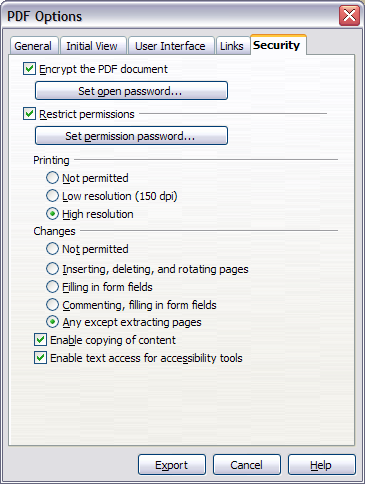
Figure 6. Security page of PDF Options dialog
- With an open password set, the PDF can only be opened with the password. Once opened, there are no restrictions on what the user can do with the document (for example, print, copy, or change it).
- With a permissions password set, the PDF can be opened by anyone, but its permissions can be restricted. See Figure 6.
- With both the open password and permission password set, the PDF can only be opened with the correct password, and its permissions can be restricted.
Note: Permissions settings are effective only if the user's PDF viewer respects the settings.
Figure 7 shows the pop-up dialog displayed when you click the Set open password button on the Security page of the PDF Options dialog box.
After you set a password for permissions, the other choices on the Security page (shown in Figure 6) become available. These selections should be self-explanatory.
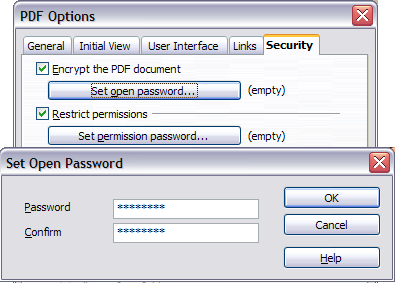
Figure 7. Setting a password to encrypt a PDF
Deleting and renaming files
You can rename or delete files within the OpenOffice.org dialogs, just as you can in your usual file manager. However, you cannot copy or paste files within the dialogs.
Renaming a file
To rename a file while using OpenOffice.org:
- Choose File > Open and browse to the required file.
- Right-click on the file name and choose Rename. The file name will be selected.
- Typing replaces the selected name, or use a left or right arrow key to move the insertion point to modify the existing name.
Deleting a file
To delete a file while using this dialog:
- Right-click on the file name to display a context menu.
- Click Delete, and you will get a confirmation dialog.
| Note | Instead of Right-click > Delete, you can simply press the Delete key. |
File associations
File associations are used to open certain types of files automatically with OpenOffice.org. You can choose to associate Microsoft Office files with OOo. If you do this, the files remain as Microsoft Office files, but the icon for the files changes to the OOo icon, and double-clicking on the icon opens the files in OOo. (You can still open the files in Microsoft Office by starting MS Office and then choosing File > Open.)
When installing OOo, you are prompted to associate file types, as shown in Figure 8. If you want to continue to open your Microsoft Office files in Office by double-clicking them, do not check these boxes. (You can open MS Office files in OOo by starting OOo and then choosing File > Open.)
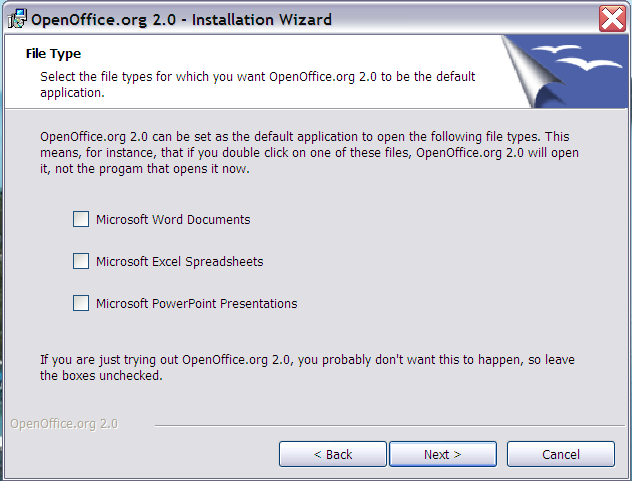
Figure 8. Choosing file associations when installing OpenOffice.org
If during installation you chose not to have OpenOffice.org automatically open Microsoft Word files, you can change this later.
- In Windows, go to Settings > Add or Remove Programs. Scroll down to OpenOffice.org 2.0 and click once on it. Two buttons should be visible: Change and Remove, as shown in Figure 9. This may appear different on your system.
- Click Change to start the Installation Wizard.
- Continue through the Installation Wizard until you reach the page shown in Figure 8. Select the file types you want OOo to open (put a mark in each checkbox) and click OK.

Figure 9. Changing the OOo installation on Windows XP
Creating new files
Different ways of creating a new document:
- Use File > New and choose the type of document.
- Use the arrow next to the New button on the main toolbar. A menu of choices (Figure 10) drops down; select the type of document to be created.
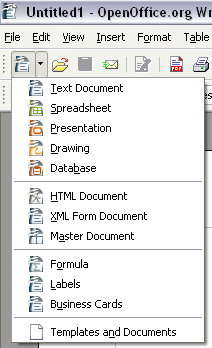
Figure 10. The New menu from the toolbar
- Use a "Quick start" program. For example, the Microsoft Windows version of OpenOffice.org has a Quickstart icon
 in the system tray. See Chapter 2 (Starting OpenOffice.org) for more information on the Quickstart icon.
in the system tray. See Chapter 2 (Starting OpenOffice.org) for more information on the Quickstart icon.
- Press Control+'N on the keyboard.
- Use File > Wizards for some types of documents. (See Figure 11.)
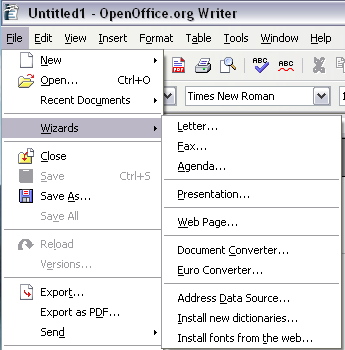
Figure 11. Creating a file using a Wizard
Using the Open and Save As dialogs
If you are using Microsoft Windows, you can choose whether to use the OpenOffice.org Open and Save As dialogs or the ones provided by Windows. To view or change which type of dialog OpenOffice.org uses:
- Choose Tools > Options > OpenOffice.org > General.
- Select the Use OpenOffice.org dialogs checkbox.
This section discusses the OpenOffice.org Open and Save As dialogs. See Figures 12 and 13 for examples of these dialogs.
The three buttons in the top right of the OOo Open dialog (Figure 12) are, from left to right:
- Go Up One Level in the folder (directory) hierarchy. This is a long-click button if you want to go up higher than just one level.
- Create New' Folder'.
- View Menu.
For OpenOffice.org documents that have been saved with more than one version, use the version drop-down to select which version you wish to open in read-only mode.
| Note | For Microsoft Office documents, only the current version can be opened. |
- inline:Frame4.png
Use the Files of type field to specify the type of file to be opened or the format of the file to be saved.
The Read-only checkbox opens the file for reading and printing only. Consequently, most of the toolbars disappear, and most menu options are disabled. An Edit File button is displayed on the Function Toolbar to open the file for editing.
It is possible to open files from the web using URLs.
- inline:Frame3.png
Digital signing of documents
To sign a document digitally, you need a personal key, the certificate. A personal key is stored on your computer as a combination of a private key, which must be kept secret, and a public key, which you add to your documents when you sign them. You can get a certificate from a certification authority, which may be a private company or a governmental institution.
When you apply a digital signature to a document, a kind of checksum is computed from the document's content plus your personal key. The checksum and your public key are stored together with the document.
When someone later opens the document on any computer with a recent version of OpenOffice.org, the program will compute the checksum again and compare it with the stored checksum. If both are the same, the program will signal that you see the original, unchanged document. In addition, the program can show you the public key information from the certificate. You can compare the public key with the public key that is published on the web site of the certificate authority.
Whenever someone changes something in the document, this change breaks the digital signature.
On Windows operating systems, the Windows features of validating a signature are used. On Solaris and Linux systems, files that are supplied by Thunderbird, Mozilla or Firefox are used. For a more detailed description of how to get and manage a certificate, and signature validation, see “Using Digital Signatures" in the OOo Help.
To sign a document:
- Choose File > Digital Signatures.
- If you have not saved the document since the last change, a message box appears. Click Yes to save the file.
- After saving, you see the Digital Signatures dialog. Click Add to add a public key to the document.
- In the Select Certificate dialog, select your certificate and click OK.
- You see again the Digital Signatures dialog, where you can add more certificates if you want. Click OK to add the public key to the saved file.
A signed document shows an icon inline:graphics19.png in the status bar. You can double-click the icon to view the certificate.
| Content on this page is licensed under the Creative Common Attribution 3.0 license (CC-BY). |

